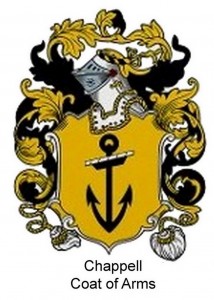 As a practical matter during the middle Ages, a Coat of Arms served as an identification on the battlefield and in sporting tournaments. With a participant’s helmet covering his entire face and armor covering his entire body from head to foot, the insignias on his chest plate and on his shield were the only means of identification for other warriors in battle and followers at sporting events.
As a practical matter during the middle Ages, a Coat of Arms served as an identification on the battlefield and in sporting tournaments. With a participant’s helmet covering his entire face and armor covering his entire body from head to foot, the insignias on his chest plate and on his shield were the only means of identification for other warriors in battle and followers at sporting events.
One of the Coat of Arms that is most associated with the Chappell name was granted on October 20, 1686, to Richard Chapell. Deputy Auditor-General and has the blazon of a gold shield with a black anchor on a gold shield. The crest consists of a crowned partial lion holding a cup in his paw.
Another record of a Coat of Arms is officially documented in the publication BURKE’S GENERAL ARMOR.
In the publication, the original description of this Chappell Coat of Arms is described as follows:
| A black anchor is positioned vertically on a gold shield between two chaplets in fess vert. Above the shield is a silver helmet with a lion’s arm and hand holding a circular shaped cup. |
This distinct symbol of identification probably became as important to our ancestors as the Chappell name itself. The Chappell Coat of Arms and shield were most certainly displayed with great pride.
